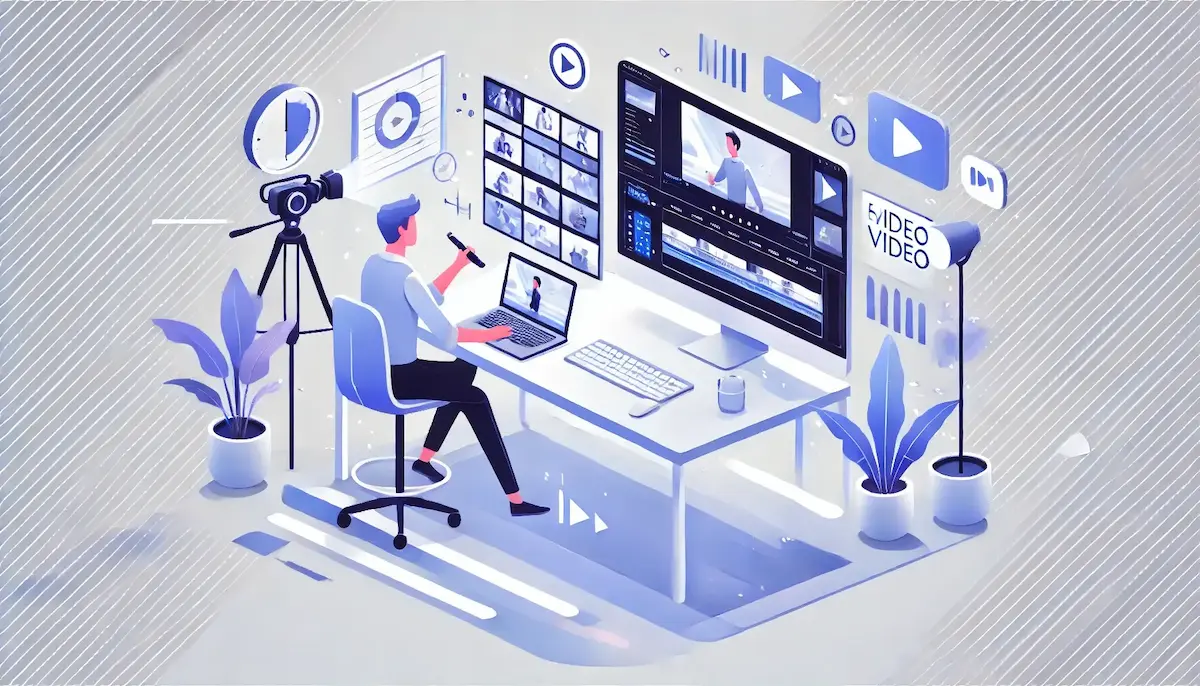Key Takeaways
- Explainer videos increase information retention by up to 67% compared to traditional text-based training materials
- Short, engaging videos (under 5 minutes) are most effective for corporate training, cutting overall training time by up to 60%
- Content Beta helps organizations transform complex training content into engaging explainer videos that simplify onboarding and boost employee engagement
- The dual-coding theory explains why videos are more effective for learning—they engage both visual and verbal processing systems simultaneously
- Companies implementing explainer videos for training report significant ROI through reduced training costs, consistent messaging, and improved compliance rates
Traditional corporate training methods are failing today’s employees. PowerPoint presentations and lengthy manuals often lead to information overload, poor retention, and disengaged team members. In an era where attention spans are shorter than ever, organizations need more effective ways to communicate critical information.
Explainer videos have emerged as the solution to this persistent training challenge. These concise, visually engaging videos transform complex concepts into digestible, memorable content that resonates with employees across all departments. Content Beta specializes in creating these high-impact training videos that cut through information clutter and deliver clear messages that stick. Our clients consistently report dramatic improvements in training outcomes and employee engagement after implementing our explainer video solutions.
Why Explainer Videos Transform Employee Training Outcomes
The human brain processes visual information 60,000 times faster than text. This fundamental cognitive reality explains why explainer videos drive such dramatic improvements in training effectiveness. When information is presented through compelling visuals paired with clear narration, your employees’ retention rates soar compared to reading documents or sitting through slide presentations.
Explainer videos eliminate the cognitive burden of deciphering complex information. By breaking down sophisticated processes, policies, or concepts into simple visual stories, these videos create instant clarity. The combination of movement, color, and sound engages multiple senses simultaneously, creating stronger neural connections and dramatically improving memory formation.
Moreover, the emotional connection fostered through well-crafted explainer videos transforms how employees respond to training. Rather than passive consumption of information, videos create an experience that resonates on both intellectual and emotional levels. This emotional engagement is the secret ingredient that makes training stick long after the video ends.

5 Types of Explainer Videos That Revolutionize Internal Training
Different training objectives require different video approaches. Understanding which style will best serve your specific needs is crucial for maximizing impact and ROI on your training investment.
1. Onboarding Videos for New Employees
First impressions matter immensely. Onboarding videos welcome new team members with engaging, consistent information about company culture, values, and essential procedures. Rather than overwhelming new hires with massive information packets, these videos provide just the right amount of information at just the right time.
Effective onboarding videos typically include welcome messages from leadership, virtual office tours, introduction to key team members, and explanations of critical first-day procedures. By standardizing this crucial information in an engaging format, companies ensure every new employee starts with the same strong foundation, regardless of who conducts their orientation.
2. Process and Procedure Tutorials
Complex workflows become instantly clearer through step-by-step visual demonstrations. Process tutorials use screen recordings, animations, and clear narration to walk employees through exact procedures, eliminating confusion and reducing errors. These videos serve as both initial training and ongoing reference resources. For more information, check out Next Day Animations for training and HR solutions.
The beauty of process videos lies in their precision and consistency. Every viewer receives identical instruction on proper procedures, eliminating the variability that occurs when different trainers explain the same process. This standardization is particularly valuable for compliance-sensitive operations where consistency is non-negotiable.
3. Safety and Compliance Training
Safety information that might seem dry in text form becomes compelling and memorable through scenario-based explainer videos. These videos can demonstrate proper techniques, illustrate potential hazards, and show the real-world consequences of safety lapses in ways that resonate emotionally with viewers.
The stakes for safety and compliance training couldn’t be higher—both for employee wellbeing and organizational liability. Explainer videos transform abstract regulations into concrete visual scenarios that employees can easily recall when facing similar situations in their actual work environment. This translation from abstract knowledge to practical application is where explainer videos truly excel.
4. Product Knowledge Animations
For sales teams, customer service representatives, and technical support staff, comprehensive product knowledge is essential. Animated explainer videos break down complex product features, demonstrate use cases, and highlight key selling points in visually memorable ways.
These videos are particularly effective for explaining technical products with features that are difficult to demonstrate in person. Through animation, invisible processes become visible, complex systems are simplified, and abstract benefits become concrete. The result is a sales and support team that can confidently explain your products with precision and enthusiasm.
5. Company Culture and Values Explainers
Corporate values often remain abstract concepts until they’re brought to life through storytelling. Culture-focused explainer videos translate your mission statement into concrete examples of values in action, helping employees understand not just what your values are, but how to embody them in daily work.
These videos are particularly powerful for distributed teams who may have fewer opportunities to absorb culture through in-person interactions. By creating a shared visual language around your organization’s purpose and principles, these videos foster unity and alignment across geographical and departmental boundaries. For more insights, explore how to boost engagement with explainer videos.

The Science Behind Video Learning: Why Your Brain Retains More
The effectiveness of video-based learning isn’t just anecdotal—it’s backed by solid cognitive science. Understanding these principles helps explain why your training investment yields significantly better returns when allocated to quality explainer videos.
“When you stimulate both the visual and auditory channels simultaneously, as happens with video, learning effectiveness increases by 40-60% compared to single-channel stimulation,” says Dr. Richard Mayer, an Educational Psychologist and Multimedia Learning Expert. For those interested in maximizing engagement, avoiding common mistakes in explainer videos can significantly enhance learning outcomes.
Visual Processing Power vs. Text-Based Learning
The human brain devotes nearly 30% of its cortex to visual processing, compared to just 8% for touch and 3% for hearing. This neurological reality explains why training materials with strong visual components dramatically outperform text-heavy alternatives. When employees watch explainer videos, their brains can process and retain vast amounts of information without the cognitive strain that accompanies reading lengthy documents.
The numbers tell a compelling story: studies consistently show that viewers retain 95% of information when it’s presented in video format, compared to only 10% when reading text. This dramatic difference in retention translates directly to improved performance, fewer errors, and reduced need for repetitive training—all of which impact your organization’s bottom line.
Dual-Coding Theory in Action
Cognitive psychologists have identified a phenomenon called dual-coding theory that explains the power of explainer videos. When information enters the brain through multiple channels simultaneously—visual and auditory—it creates two separate memory traces instead of just one. This redundancy significantly increases the likelihood that employees will recall the information when needed, even under pressure or after significant time has passed.
Explainer videos leverage this cognitive advantage by presenting synchronized visual and verbal information. The narration explains concepts while corresponding visuals reinforce the message, creating those crucial dual memory pathways. This is particularly valuable for procedural training, where precise recall of specific steps can be critical to job performance and safety.
Emotional Connection and Memory Formation
The most memorable training doesn’t just present information—it creates an emotional response. Neuroscience research confirms that emotional engagement significantly strengthens memory formation by activating the amygdala, which enhances the encoding and storage of associated memories. Well-crafted explainer videos leverage storytelling, characters, and visual metaphors to create this emotional resonance.
When employees feel something while learning—whether it’s amusement, surprise, or even mild tension resolved by understanding—they’re far more likely to remember and apply that information. This emotional dimension is often entirely absent from traditional training materials but can be masterfully incorporated into professional explainer videos.
Measurable Benefits of Training Explainer Videos
Beyond the cognitive science, the business case for implementing explainer videos in corporate training is compelling. Organizations across industries report concrete, measurable improvements after incorporating these videos into their training programs.
67% Increase in Information Retention
Multiple studies have documented the dramatic improvement in knowledge retention when training shifts from text-based to video-based formats. This retention advantage persists over time, with video-trained employees demonstrating superior recall even months after the initial training. The practical impact is fewer errors, less need for retraining, and more consistent application of procedures.
This retention benefit is particularly pronounced for complex or technical information that might otherwise require multiple readings to comprehend. Explainer videos break down complexity through visual metaphors and step-by-step illustrations, making even sophisticated concepts accessible and memorable.
Training Time Reduction by Up to 60%
Time is perhaps the most valuable resource in any organization, and traditional training methods consume enormous amounts of it. Explainer videos dramatically compress learning curves by presenting information in its most efficient format. A concept that might take 15 pages to explain in text can often be communicated in a 3-minute video with far better comprehension and retention.
This efficiency translates directly to cost savings. Employees spend less time in training and reach proficiency faster, reducing both direct training costs and the opportunity cost of time spent away from productive work. For organizations with large workforces or frequent onboarding needs, these savings can be substantial.
Consistent Messaging Across All Teams
Training inconsistency creates operational risk. When different trainers explain the same process with slight variations, it leads to confusion, procedural drift, and potential compliance issues. Explainer videos eliminate this variability by delivering identical information to every viewer, ensuring everyone receives the same high-quality instruction regardless of location, department, or training schedule.
Multilingual Capabilities for Global Teams
For multinational organizations, ensuring consistent training across language barriers presents a significant challenge. Explainer videos offer an elegant solution through easily swappable narration tracks and subtitles. The visual component remains consistent across all versions, while the audio can be professionally translated to maintain both accuracy and cultural relevance.
This multilingual capability enables truly global training programs without the expense of developing separate materials for each market. It also ensures that every employee receives equally effective training, regardless of their primary language.
How to Create Effective Training Explainer Videos
Creating explainer videos that deliver real training value requires strategic planning and attention to both content and presentation. The most effective videos balance information density with engagement, presenting complex ideas in accessible, memorable ways.
Whether you’re working with a professional production team like Content Beta or developing videos in-house, these principles will help maximize the impact of your training explainer videos.
Start With Clear Learning Objectives
Every effective training video begins with precisely defined learning objectives. What specific knowledge, skills, or actions should viewers take away from this video? These objectives should guide every aspect of the video’s development, from script to visuals to interactive elements. Without this clarity, videos risk becoming entertaining but ineffective.
Keep Videos Under 5 Minutes
Attention spans in the workplace are limited, and training effectiveness drops dramatically as video length increases. Research shows that engagement peaks at around 2-3 minutes and begins declining significantly after 5 minutes. Rather than creating one long video, break complex topics into a series of focused micro-learning modules that each address a specific aspect of the larger subject.
Use Storytelling to Drive Engagement
Information embedded in stories is remembered far better than abstract facts or instructions. Effective training videos use narrative structures to create context and meaning around the information being presented. This might involve following a character through a process, presenting a problem-solution scenario, or using metaphors that connect new information to familiar concepts.
Include Interactive Elements
Passive viewing limits learning potential. Modern training platforms allow for the inclusion of interactive elements within videos—knowledge checks, clickable hotspots, branching scenarios, and reflection questions. These interactions transform viewers from passive recipients into active participants, dramatically increasing both engagement and retention. Even simple interactions like periodic comprehension questions can increase knowledge retention by up to 25%.

Tools and Software for DIY Explainer Videos
While professional-quality explainer videos deliver the best training outcomes, organizations with budget constraints or simple training needs can create effective videos in-house. The market now offers numerous user-friendly tools that simplify the video creation process, even for those without extensive design or production experience.
These DIY approaches work best for straightforward training content where professional polish is less critical than simply conveying information clearly. For complex topics or training that represents your brand to customers or high-value recruits, professional production typically delivers better results and ROI.
Animation Platforms for Non-Designers
Template-based animation platforms like Vyond, Powtoon, and Animaker offer drag-and-drop interfaces that allow non-designers to create professional-looking animated videos. These platforms provide character libraries, background settings, and pre-animated sequences that can be customized to fit your specific training content. While they lack the uniqueness of custom animation, they offer a significant step up from static presentations for organizations on tight budgets.
Screen Recording and Editing Tools
For software training and process demonstrations, screen recording tools like Camtasia, Screencast-O-Matic, and Loom offer the simplest path to creating clear instructional videos. These platforms allow trainers to capture on-screen actions while recording narration, then enhance the recordings with zoom effects, callouts, and basic editing. The learning curve is minimal, making this approach accessible to subject matter experts without video production experience.
Voice-Over Resources and Best Practices
Clear, professional narration dramatically impacts training video effectiveness. While professional voice talent delivers the best results, budget-conscious teams can achieve acceptable quality using team members with clear speaking voices. Invest in a decent USB microphone, record in a quiet environment with soft surfaces to absorb echo, and script your narration for spoken language rather than written text—shorter sentences, active voice, and conversational tone all improve comprehension.
If budget allows, online voice marketplaces like Voice123 and Voices.com offer affordable professional narration services that significantly elevate video quality. Professional voice actors bring clarity, engagement, and proper pacing that amateur recordings typically lack.
- Animation tools: Vyond, Powtoon, Animaker, Doodly
- Screen recording: Camtasia, Screencast-O-Matic, Loom, OBS Studio
- Video editing: Adobe Premiere Rush, Filmora, iMovie, DaVinci Resolve
- Voice recording: Audacity, Adobe Audition, GarageBand
- Script writing: Final Draft, Celtx, Google Docs with Table format

Remember that the quality of your training videos directly impacts their effectiveness. If your team lacks the time or skills to produce professional-quality content, partnering with specialists like Content Beta often delivers better results and stronger ROI than struggling with in-house production.
When to Hire Professionals vs. Creating In-House
The decision to create explainer videos in-house or partner with professional production teams hinges on several factors, including budget, technical complexity, intended audience, and strategic importance of the training. While DIY tools have improved dramatically, professional productions still deliver significant advantages in quality, effectiveness, and ultimately ROI for many training scenarios.
Budget Considerations and ROI Calculations
Professional explainer videos typically range from $2,000 to $10,000 depending on length, style, and complexity. While this initial investment may seem substantial compared to in-house production, the calculation changes when considering total cost of ownership. Factor in the time your team would spend learning tools, writing scripts, creating visuals, recording and editing—often 20-40 hours for a single effective video—and the professional option frequently proves more economical. For more insights, explore how to convert viewers into customers with explainer videos.
The ROI equation should also consider effectiveness. Professional videos typically deliver higher engagement, better retention, and stronger behavioral change—the ultimate goal of any training initiative. A professionally produced video that achieves your training objectives delivers better value than a lower-cost video that fails to change behavior or transfer knowledge effectively.
Complexity Assessment Checklist
Certain training content benefits substantially from professional production approaches. Consider professional production when your training involves complex visual explanations, requires custom character animation, needs to maintain consistent branding, or will be viewed by external stakeholders like customers or potential recruits. Similarly, training on high-stakes topics like safety procedures or compliance issues usually warrants professional quality to ensure clarity and impact.
In-house production works best for time-sensitive updates, simple software demonstrations, and content with short shelf life. These scenarios favor speed and agility over polish, making DIY approaches more practical despite quality limitations.
Real-World Success: Companies Winning With Explainer Videos
Organizations across industries have transformed their training outcomes through strategic implementation of explainer videos. These success stories provide both inspiration and practical insights for your own training video initiatives.
How Google Cut Onboarding Time by 50%
Google famously redesigned its onboarding process around a series of targeted explainer videos that new employees could consume at their own pace. This video-centric approach reduced overall onboarding time by nearly 50% while improving knowledge retention and employee satisfaction scores. The modular design allowed employees to focus on role-specific content while ensuring everyone received consistent information about company culture, policies, and core processes.
Safety Compliance Improvements at Manufacturing Companies
Manufacturing companies face unique challenges in safety training, where theoretical knowledge must translate immediately to practical application in high-risk environments. Several major manufacturers have documented impressive improvements after implementing explainer video programs for safety training.
A leading automotive manufacturer reduced workplace incidents by 47% in the first year after replacing text-based safety manuals with scenario-based explainer videos. These videos demonstrated proper equipment handling, emergency procedures, and hazard identification using realistic shop floor scenarios. The visual nature of the videos made abstract safety concepts concrete and memorable, particularly for visual learners who struggled with text-heavy materials.
Similarly, a chemical processing company achieved 100% compliance with mandatory safety certification by transforming complex OSHA regulations into a series of clear, engaging explainer videos. Each video focused on a specific safety protocol, using animation to visualize invisible threats like gas leaks or chemical reactions. The completion rate for safety training jumped from 68% to 98%, while knowledge assessment scores improved by an average of 23 percentage points.

Implementation Strategy: Rolling Out Video Training
Successfully implementing explainer videos requires more than simply creating great content. You need a comprehensive strategy that addresses integration with existing systems, measurement of effectiveness, and continuous improvement processes. With thoughtful planning, video-based training can seamlessly enhance your existing learning ecosystem rather than disrupting established workflows.
Integration With Existing LMS Platforms
- SCORM/xAPI compatibility for tracking completion and assessment results
- Single sign-on implementation for seamless user experience
- Bandwidth and device compatibility considerations for various viewing environments
- Progressive download options for locations with limited connectivity
- Mobile optimization for learning on the go
Most modern Learning Management Systems (LMS) support video content, but configuration details matter tremendously for user experience and data collection. Ensure your videos are properly formatted with SCORM or xAPI wrappers that enable your LMS to track not just completion but also interaction points, quiz responses, and time spent on specific sections.
Consider the viewing environment when planning integration. Will employees watch these videos at their desks, on factory floors, in field locations, or on mobile devices during commutes? Each scenario may require different video specifications, download options, or playback controls to ensure optimal learning experiences.
For organizations without a formal LMS, simple hosting solutions like Vimeo Business, Wistia, or even private YouTube channels can provide basic tracking and engagement metrics. These platforms offer password protection, domain restrictions, and viewer analytics without the complexity of full LMS implementation.
Remember that accessibility requirements apply to training videos. Ensure your implementation includes closed captioning, transcripts, and compatibility with screen readers to accommodate all learners and comply with regulations like the Americans with Disabilities Act.
Tracking Engagement and Completion Rates
Effective measurement transforms training from a cost center to a strategic investment with demonstrable ROI. Modern video platforms provide rich analytics that go far beyond simple completion rates, offering insights into viewer behavior that can inform both content improvements and performance interventions.
Pay particular attention to drop-off points—moments in videos where viewers stop watching or skip ahead. These often indicate content that’s confusing, irrelevant, or simply not engaging. High drop-off sections should be prime candidates for revision in future updates.
Heat maps showing rewatched sections can identify both problematic content (viewers repeatedly reviewing because they don’t understand) and particularly valuable content (viewers returning to reference important information). This data helps you understand which parts of your training truly resonate with learners.
- View completion rates across departments and roles
- Time spent on each video segment
- Quiz response accuracy for embedded assessments
- Rewatch patterns for complex content
- Device and time-of-day viewing patterns
Gathering Employee Feedback for Improvement
Quantitative metrics tell only part of the story. Complement your analytics with structured feedback mechanisms that capture qualitative insights about the learning experience. Simple post-video surveys, focus groups with representative users, and integration of feedback tools directly within the video player can provide invaluable perspective on what’s working and what needs improvement.
Future-Proof Your Training: Beyond Basic Explainer Videos
As technology evolves, so do the possibilities for creating even more effective training experiences. Forward-thinking organizations are already exploring the next generation of video-based learning that offers greater personalization, interactivity, and immersion. These emerging approaches build on the proven benefits of explainer videos while addressing limitations and opening new possibilities for complex skill development.
Interactive Video Technologies
Traditional linear videos are giving way to interactive experiences where learners make choices that affect content flow. These branching scenarios allow employees to practice decision-making in realistic simulations, receiving immediate feedback on their choices. The result is not just knowledge transfer but skill development through applied practice in a safe environment.
Advanced interactive video platforms like Rapt Media, HapYak, and H5P enable the creation of clickable hotspots, decision points, embedded quizzes, and learner-directed exploration. These features transform passive viewing into active participation, dramatically increasing engagement and knowledge application.
- Branching scenarios with multiple outcome paths
- In-video knowledge checks with adaptive content
- Clickable objects that reveal additional information
- Choose-your-own-adventure training narratives
- Embedded simulations for practical application
The data generated by these interactions provides unprecedented insight into not just what employees know but how they apply that knowledge in simulated scenarios. This allows for much more sophisticated assessment of training effectiveness and learner readiness for real-world application. To learn more about creating effective training content, explore our custom animated videos.
While development costs for fully interactive videos typically exceed those of traditional explainer videos, the enhanced engagement and assessment capabilities often justify the investment for high-stakes training or complex decision-making scenarios.
Microlearning Series Development
Rather than creating comprehensive videos that cover entire topics, leading organizations are embracing microlearning—brief, focused videos that address single concepts or procedures. These bite-sized modules, typically 1-3 minutes in length, align perfectly with how the brain forms and retrieves memories, while accommodating the fragmented attention realities of modern workplaces.
The most effective microlearning videos focus on specific performance objectives rather than general knowledge. Each video should enable the learner to immediately apply a specific skill or piece of knowledge, creating a direct line between training and improved performance. When organized into thoughtfully structured learning paths, these micromodules build systematically toward comprehensive mastery while allowing for flexible, self-directed learning. For more insights on creating impactful content, explore our guide on mistakes to avoid in explainer videos.
AR/VR Integration Possibilities
Augmented and virtual reality represent the frontier of immersive learning, and forward-thinking training departments are already exploring integration with explainer video content. These technologies enable experiential learning that was previously impossible or prohibitively expensive to deliver at scale.
VR training allows employees to practice complex procedures in realistic simulations before attempting them in the real world. From medical procedures to equipment maintenance to emergency response, VR provides consequence-free practice opportunities that build both competence and confidence. The immersive nature of VR creates powerful memory associations that significantly outperform traditional learning methods for procedural and spatial skills.
AR applications overlay instructional content onto the real world, providing just-in-time guidance as employees perform actual tasks. This capability transforms traditional explainer videos from preparatory training into real-time performance support, fundamentally changing when and how training content is consumed. Major manufacturers are already implementing AR work instructions that reduce error rates by up to 90% compared to traditional documentation.

Your Action Plan: Next Steps to Transform Training
Start your explainer video journey by identifying one high-value training process that affects multiple employees and has clear success metrics. Pilot your first video in this area, carefully measuring both learning outcomes and employee feedback. Use this initial experience to refine your approach before expanding to additional training areas.
Consider partnering with Content Beta for your first professional training videos. Our team specializes in transforming complex corporate training content into engaging, effective explainer videos that deliver measurable results. We’ll guide you through the entire process, from script development to final delivery, ensuring your videos achieve both educational objectives and engagement goals.
Frequently Asked Questions
Q: How long should a training explainer video be?
That said, certain technical training may require longer formats. In these cases, structure the content with clear chapters, progress indicators, and interaction points approximately every 3-4 minutes to maintain engagement throughout the longer viewing experience.
Q: What’s the average cost to produce a professional explainer video?
Q: Can explainer videos replace in-person training completely?
The most effective training programs use explainer videos to establish foundational knowledge before in-person sessions, allowing valuable face-to-face time to focus on application, practice, and complex problem-solving rather than basic information delivery. This approach maximizes the impact of both learning modalities while reducing overall training time and cost.
Q: How do I measure the ROI of implementing explainer videos?
Q: What’s the best format for training videos that need frequent updates?
Screen recording formats typically allow for easier updates than animation, making them ideal for software training on platforms that receive frequent updates. Some production companies offer maintenance packages that include regular updates at reduced rates compared to initial production costs.
Content Beta specializes in creating training videos designed for long-term value, with smart structural approaches that minimize update costs while maintaining engagement and effectiveness. Contact us today to discuss how we can help your organization transform its training approach through strategic use of explainer videos.
Explainer videos are an effective tool for training, HR, and internal use within organizations. They can simplify complex information and make it more engaging for employees. By using custom animated explainer videos, companies can enhance communication and boost understanding across various departments.





